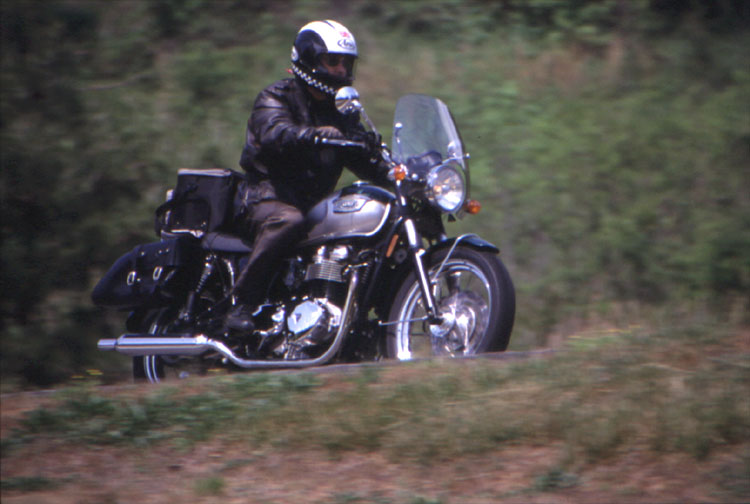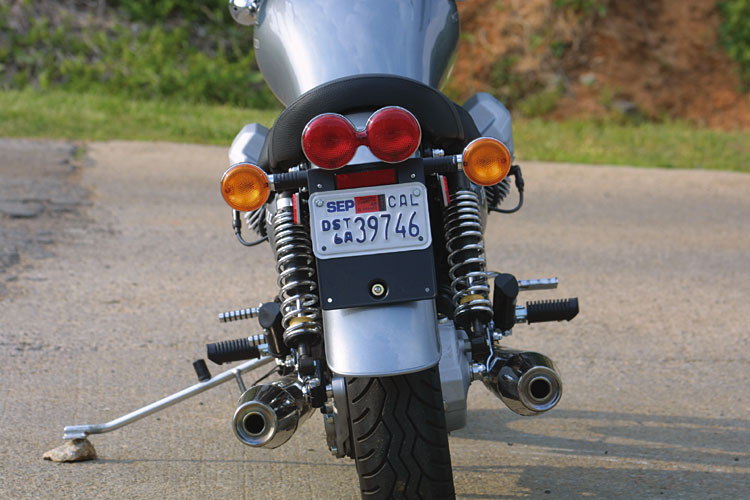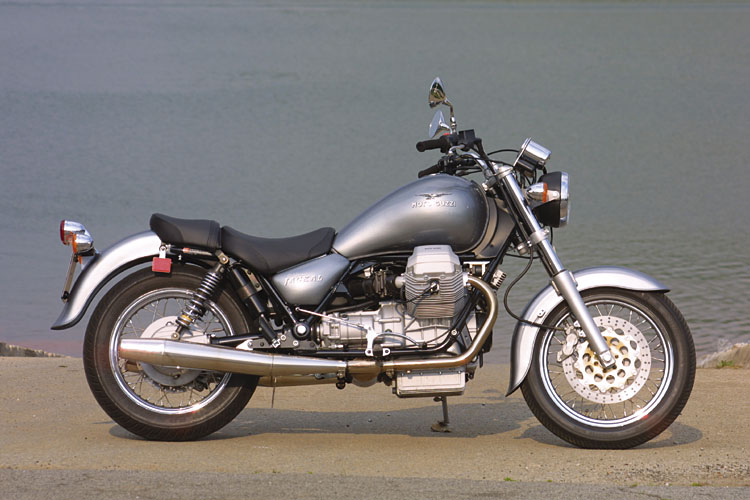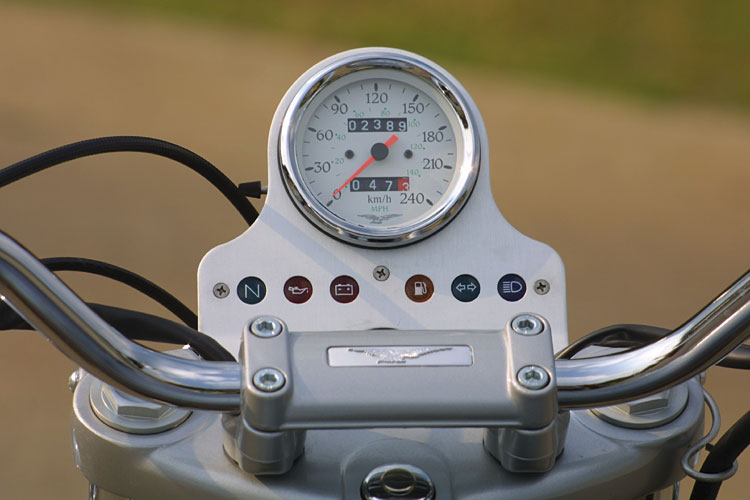Moto Guzzi California Jackal - Triumph Bonneville

There are more ways to ride your cruiser around than you would expect. RoadRUNNER Motorcycle Cruising & Touring took the opportunity to check the all-round abilities of two classic European bikes on the twisty roads of Georgia and North Carolina.
We are riding under a deep green canopy of leaves, breathing big draughts of fresh air and dancing wherever the road dictates. There is no way out of here: "The Dragon" has got us and the footrests of the Bonnie are spewing fire and sparks as if we are actually fighting the mythical creature. Though it seems to be a hard clash, the bike runs the line the rider induces. The Bonnie and I try to follow Christian and the Guzzi. They seem to be a couple of tough customers for "The Dragon," too, especially when the Jackal growls and bares its teeth. But it's not over; the outcome is yet to be decided. We have covered only a third of the 311 turns on this 11-mile stretch near Deals Gap, North Carolina, a back road famous for its curves, nice panorama, fast, native riders, and unfortunately its victims.
Surprisingly, the two classic bikes can handle this labyrinth of curves very well. Although made for easy cruising, they can be ridden more aggressively than you might usually expect. And on twisty streets like Deals Gap, you don't need a lot of horsepower; it's more about easy handling, good torque or mid range performance and the abilities of the rider.

Talking About Tradition
Both bikes have great heritages. The Jackal is based on the California theme of Moto Guzzi but has fewer parts and accessories than its former and current relatives, all of which saves the customer some hard-earned cash. The V-Twin in a double cradle frame has been a real eye-catcher since the V 7 Eldorado of the late sixties and early seventies and is the same as other relevant California models. Over thirty years ago, riders appreciated this arrangement because it allowed them to go on long trips without worrying too much about fuel mileage, chain lubing or a sore back. The Guzzis were known for their large fuel tank, clean, reliable shaft drive, and relaxed seating position. The new models remain pretty close to their ancestors but are improved in many details.
The Triumph is visually, and even in some parts technically, a remake of those successful Bonneville models that came over to North America like a thunderstorm. After Johnny Allen's speed record of 215 mph (344 km/h) on a 650 Triumph scorched the salt flats of Bonneville in Utah, the young motorcycle crowd was screaming for a four-stroke inline two from Great Britain. And the folks in Coventry, over in the UK, heard them. In 1959, they introduced the T 120 Bonneville: two cylinders, two carbs, pushrods and rockers, 400 lbs. (180 kg), top speed over 122 mph (179 km/h). It was a very desirable bike at the time. It even made it into a cult movie, "The Wild One" with Marlon Brando, which depicts the incidents in Hollister when a motorcycle crowd took over the town - an event that was more peaceful than most of the newspapers reported. By the way, it was mostly an event for British makes like Triumph, BSA, Norton, etc., and not a meeting for the American brands like people would have you believe nowadays.

Chassis & Brakes
But enough of the history lesson, back to the present. The performance of the two competitors in this test, depending on their ability to be ridden hard around the curves, is surprisingly high for cruisers. The Guzzi needs more input if you want to make it fast through the turns. And it runs a steady line. Making a quick change needs more effort than on the Triumph, which has more agility. On the other side, the wide handlebars of the Jackal give you a good lever with which to lead it into the curves. Because of the long swingarm, the rear end doesn't move up and down like it does on other shaft-driven bikes when you switch gears.
Something the two competitors have in common is the fading of the single front disc when you push very hard, although the Guzzi's hand lever doesn't move as close to the handlebar as it does on the Triumph. But the Bonnie makes up for it. Its more conventional geometry, with a trail of 98 millimeters (3.9 in.) and a rake of 62 degrees, is closer to a standard than to a cruiser. And this is one of the reasons for its easy handling. Also, the British bike carries less weight, 27 kilograms (60 lbs.), and uses narrower tires (100/90-19/130/80-17 versus the 110/90 VB 18/140/80 VB 17 of the Jackal). Another important difference between the Bonnie and the Italian stallion are the seating positions. On the Triumph, with its lower handlebars and footrests mounted farther back, you can put more weight on the front wheel. That improves the feedback of the front end. On the Guzzi, the rider's legs have to stretch more forward and the upper body leans back more.

Engine & Transmission
The torque and power an engine produces also determines performance. Here the Jackal is our favorite because its V-Two (75 hp at 6,400 rpm, 9.6 mkp/71 ftlbs. at 5,000 rpm) works just fine with the fuel injection and produces a wide range of these forces. Just a little move on the throttle gives you enough swing to make it through narrow turns. Shifting gears, even if the distance between them is a little bit long, works so easily compared to former Guzzi models that it is just plain fun. The big capacity, in combination with the perfectly operating fuel injection, allows using third and fourth in twisty curves whereas you have to shift down one or two gears on the Triumph to get enough torque out of it.
No big deal because the gearbox of the British inline twin has short transitions and ratios between the gears. That makes life a lot easier on curvy roads. "The Dragon" won't eat you for breakfast, lunch or dinner! Also, the straight and sturdy seat of the Triumph gives you more feedback from the pavement and still offers enough comfort. Of course, 790 cc in the setup the Bonnie uses (inline two, dohc, four valves per cylinder, shims under buckets, two balancers, two carburetors) can't produce the same power and beat like the old pushrod engine from Italy with 1,064 cc and a modern fuel arrangement. For comparison: The Triumph makes 61 hp at 7,400 rpm and 6.1 mkp/45 ftlbs. at 3,500 rpm. But a little bit more sound character would fit much better to the classic style of the British bike. The factory offers a set of pipes and a jet kit, and with this setup the new Bonnie really reminds you of the Marlon Brando era.

Accessories & Arrangements
If you like pure bikes and unadulterated characters you can't miss with either bike. The Jackal is the ideal basic bike to go cruising and to show off on the boulevard. Just lean back and relax, the engine and chassis will do the job. A single speedometer with some warning lights is enough, and the rear seat offers enough comfort for the passenger; even though it could be a little bit longer. Missing the Guzzi-patented combined brake system doesn't bother us but we would like to have the second rotor in the front. And it wouldn't hurt to have some adjustable hand levers. Making up for that, the heavy mudguards offer better protection from dirt and water compared to the Triumph's smaller units. Another nice thing: Guzzi's machinery and electronics are solid and reliable nowadays.

The Triumph setup is similar depending on the accessories. You get a speedometer without a tach, but the warning lights are not bright enough. On sunny days you have difficulty telling whether a light is on or not. The seat is long enough and comfortable for rider and passenger and on the handlebars you have the opportunity to adjust the levers to your finger/hand size. The windscreen (Triumph accessory) on our test bike worked just fine keeping rain and wind away from the rider's upper body. But the additional luggage boxes offer only a tiny opening which makes packing a lot more difficult. Also, the way the boxes were strapped to the sidebars with the buckles in the inside made it impossible to take them off fully loaded. The ignition switch is on the left side of the front light. The bike lock sits on the right side of the steering head tube and the choke on the right side of the carbs. The polished and chrome-plated engine-side covers look nice and perfectly complement the classic look of the bike. Another nice thing on the Triumph: The engine is reliable and doesn't leak as it did in the good old days. Your garage floor will stay clean.

Test Summary
Both bikes offer a wide range of usability; cruising, touring and back road riding. The Triumph in this setup offers more touring character, but a luggage rack and boxes are also available for the Guzzi. The Jackal bares its teeth when it comes to engine performance while the Bonnie handles better. In both cases we would prefer two disc setups on the front brake. But in the end they are both fit companions for that group of riders who want a pure, stylistically traditional motorcycle with a modern engine and chassis. As far as we can tell, "The Dragon" can get you on both of them but it can't keep you.

Technical Specs
Retail price $ 8,495
Warranty Three years or unlimited mileage
Maintenance schedule 1,000/6,000/every 6,000 miles (1,500/10,000/every 10,000 km)
Importer/distributor Moto America
455 W. Depot Street
Angier, NC 27501
(800) 872-6686
Moto Guzzi Italy
Engine
Type 2-cylinder V, 4-stroke
Cooling Air-cooled
Valve arrangement 2 valves per cyl., ohv, cam chain driven, pushrodsand rockers
Bore & Stroke 92 x 80 mm
Displacement 1,064 cc
Compression ratio 9.5:1
Carburetion Electronic fuel injection
Exhaust emission control -
Transmission
Gearbox 5-speed
Clutch Two-plate dry clutch, hydraulically operated
Final drive Shaft drive
Chassis
Frame Steel tubular frame, double cradle
Wheelbase 1,575 mm (62 in.)
Rake 62 degree
Trail 98 mm (3.9 in.)
Front suspension Inverted cartridge fork
Stanchion diameter 45 mm (1.77 in.)
Adjustments Spring preload
Travel 124 mm (4.9 in.)
Rear suspension Steel swingarm w/two shocks
Adjustments Spring preload
Travel 114 mm (4.5 in.)
Wheels & Tires
Type Spoke wheels w/chrome-plated steel rims
Front 2.50 x 18
Rear 3.50 x 17
Front Tire 110/90 VB 18
Rear Tire 140/80 VB 17
Brakes
Front brake 1 disc, 4-piston caliper
Diameter 320 mm (12.6 in.)
Rear brake 1 disc, 2-piston caliper
Diameter 282 mm (11.1 in.)
Combining -
Weight & Fuel Capacity
Dry-Weight 257 kg (571 lb.)
Fuel capacity 19 l (5 gal.)
Performance
Claimed Horsepower (crank) 75 hp at 6,400 rpm
Torque 9.6 mkp (71 ftlbs.) at 5,000 rpm
Top speed 187 km/h (117 mph)
Acceleration 0-100 km/h (0-62.5 mph): 4.6 s
Fuel consumption 5.9 l/100 km (40.3 mpg)
Fuel range 322 km (201 miles)
Equipment
Dashboard w/speedometer, odometer and trip-odometer, two petcocks with position for fuel reserve and additional warning light, key switch in the center of the dashboard, helmet lock, side stand.
RoadRUNNER Test Diagram
Engine 4/5
Chassis 4/5
Brakes 3/5
Comfort 3/5
Luggage w/accessories 3/5
Equipment 3/5
Design 5/5
Bike for the buck 4/5
Triumph Bonneville
Retail price $ 6,999
Warranty Two years (unlimited mileage)
Maintenance schedule 500/3,000/every 3,000 miles (800/5,000/every 5,000 km)
Importer/distributor Triumph Motorcycles America, Ltd.
385 Walt Sanders Memorial Drive
Newnan, GA 30265
phone (678) 854-2010, fax (678) 854-2025
Engine
Type 2-cylinder inline, 4-stroke
Cooling air-cooled
Valve arrangement 4 valves per cyl., dohc, cams chain driven, shim under bucket adjustment
Bore & Stroke 86 x 68 mm
Displacement 790 cc
Compression ratio 9.2:1
Carburetion two 36 mm carburetors
Transmission
Gearbox 5-speed
Clutch Multi-plate wet clutch, mechanically operated
Final drive Chain drive
Chassis
Frame Steel tubular frame, double cradle
Wheelbase 1,435 mm (58.8 in.)
Rake 117 degree
Trail 117 mm (4.6 in.)
Front suspension Inverted cartridge fork
Stanchion diameter 41 mm (1.6 in.)
Adjustments-
Travel 120 mm (4.7 in.)
Rear suspension Steel swingarm w/two shock
Adjustments Spring preload
Travel 105 mm (4.1 in.)
Wheels & Tires
Type Spoke wheels w/chrome-plated steel rims
Front 2.50 x 19
Rear 3.50 x 17
Front Tire 100/90-19
Rear Tire 130/80-17
Brakes
Front brake 1 disc, floating double-piston caliper
Diameter 310 mm (12.2 in.)
Rear brake 1 disc, floating double-piston caliper
Diameter 255 mm (10.0 in.)
Combining -
Weight & Fuel Capacity
Dry-Weight 230 kg (511 lb.)
Fuel capacity 16 l (4.2 gal.)
Performance
Claimed Horsepower (crank) 61 hp at 7,400 rpm
Torque 6.1 mkp (45 ftlbs.) at 3,500 rpm
Top speed 178 km/h (111 mph)
Acceleration 0-100 km/h (0-62.5 mph): 5.8 s
Fuel consumption 5.4 l/100 km (44 mpg)
Fuel range 271 km (169 miles)
Equipment
Dashboard w/speedometer, odometer and trip-odometer, ignition switch at left side of the headlight, lock at the right side of the steering head tube, helmet lock, choke lever on the left carburetor, side stand.
RoadRUNNER Test Diagram
Engine 3/5
Chassis 4/5
Brakes 3/5
Comfort 4/5
Luggage w/accessories 4/5
Equipment 3/5
Design 5/5
Bike for the buck 4/5






